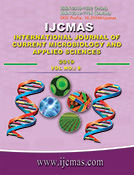


 National Academy of Agricultural Sciences (NAAS)
National Academy of Agricultural Sciences (NAAS)

|
PRINT ISSN : 2319-7692
Online ISSN : 2319-7706 Issues : 12 per year Publisher : Excellent Publishers Email : editorijcmas@gmail.com / submit@ijcmas.com Editor-in-chief: Dr.M.Prakash Index Copernicus ICV 2018: 95.39 NAAS RATING 2020: 5.38 |
A two-year field experiment was conducted during boro seasons of 2015 and 2016 at Research Farm of Institute of Agriculture, Visva-Bharati University, Sriniketan, West Bengal, India. The experiment was laid out in a Randomized Block Design with three replications and fifteen treatments in a typical Lateritic soil of West Bengal. The soil properties of the experimental site ware sandy loam with acidic in reaction; low in organic carbon, low in available nitrogen, phosphorus, potassium, sulphur and boron; medium in available zinc. After harvesting of boro rice, soil samples were analyzed for soil reaction, electrical conductivity, organic carbon, available N, P, K, S, B and Zn. Application of 2.2 kg B ha-1, 4.2 kg Zn ha-1, 0.26 kg Mo ha-1, 20 kg S ha-1, RDF along with 2.5 t Vermicompost ha-1 and 6 kg Azospirillum ha-1 were showed significantly highest grain yield of boro rice. i.e. 6.66 t ha-1 (T13) followed by T12, T11, T8, T5, T9, T6, T4, T14, T7, T10, T15, T3, T2 and T1. Integrated nutrient management increased the availability of N, P, K, S, B and Zn in soil and also increased the yield of boro rice.
 |
 |
 |
 |
 |